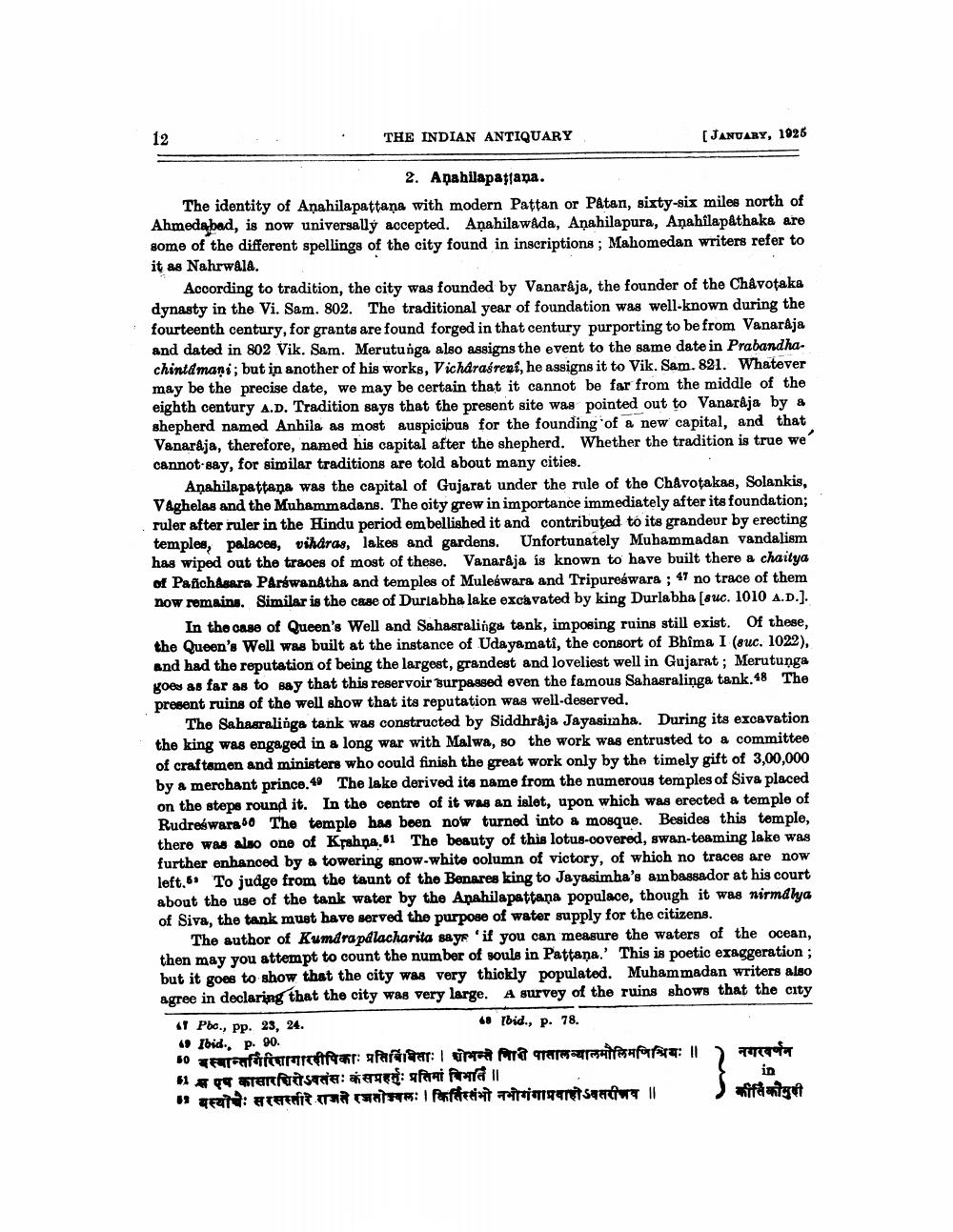________________
THE INDIAN ANTIQUARY
[JANUARY, 1926
2. Apahilapajjana. The identity of Anahilapattana with modern Pattan or Patan, sixty-six miles north of Ahmedabad, is now universally accepted. Anahilawada, Anahilapura, Anahilapathaka are some of the different spellings of the city found in inscriptions ; Mahomedan writers refer to it as Nahrwala.
According to tradition, the city was founded by Vanarâja, the founder of the Châvotaka dynasty in the Vi. Sam. 802. The traditional year of foundation was well-known during the fourteenth century, for grants are found forged in that century purporting to be from Vanaraja and dated in 802 Vik. Sam. Merutunga also assigns the event to the same date in Prabandhachintamani; but in another of his works, Vicharaśrepi, he assigns it to Vik. Sam. 821. Whatever may be the precise date, we may be certain that it cannot be far from the middle of the eighth century A.D. Tradition says that the present site was pointed out to Vanaraja by & shepherd named Anbila as most auspicious for the founding of a new capital, and that Vanaråja, therefore, named his capital after the shepherd. Whether the tradition is true we cannot say, for similar traditions are told about many cities.
Anahilapattana was the capital of Gujarat under the rule of the Chåvotakas, Solankis, Vaghelas and the Muhammadans. The oity grew in importance immediately after its foundation; ruler after ruler in the Hindu period embellished it and contributed to its grandeur by erecting temples, palaces, vihdras, lakes and gardens. Unfortunately Muhammadan vandalism has wiped out the traces of most of these. Vanarâja is known to have built there a chaitya of PanchAsara Perswanatha and temples of Muleswara and Tripureswara ; 47 no trace of them now remains. Similar is the case of Durlabha lake excavated by king Durlabha (suc. 1010 A.D.).
In the case of Queen's Well and Sahasralinga tank, imposing ruins still exist. Of these, the Queen's Well was built at the instance of Udayamati, the consort of Bhima I (suc. 1022), and had the reputation of being the largest, grandest and loveliest well in Gujarat ; Merutunga goes as far as to say that this reservoir surpassed even the famous Sahasralinga tank.48 The present ruins of the well show that its reputation was well-deserved.
The Sahasralinga tank was constructed by Siddhrája Jayasira ha. During its excavation the king was engaged in a long war with Malwa, so the work was entrusted to a committee of craftsmen and ministers who could finish the great work only by the timely gift of 3,00,000 by a merchant prince.49 The lake derived its name from the numerous temples of Siva placed on the steps round it. In the centre of it was an islet, upon which was erected a temple of Rudreswara 60 The temple has been now turned into a mosque. Besides this temple, there was also one of Krahna,61 The beauty of this lotus-oovered, swan-teaming lake was further enhanced by a towering snow-white column of victory, of which no traces are now left.6. To judge from the taunt of the Benares king to Jayasimha's ain bassador at his court about the use of the tank water by the Apahilapattana populace, though it was nirmdlya of Siva, the tank must have served the purpose of water supply for the citizens.
The author of Kumdra pdlacharita says 'if you can measure the waters of the ocean, then may you attempt to count the number of souls in Pattana.' This is poetic exaggeration ; but it goes to show that the city was very thickly populated. Muhammadan writers also agree in declaring that the city was very large. A survey of the ruins shows that the city 41 Pbc., pp. 23, 24.
** Ibid., p. 78. * Ibid., p. 90. 50 Traffertfar: sfarsiarar: Orta a refereres afsta: 1) नगरवर्णन स एप कासारविरोऽवतंस कंसपहर्तुः प्रतिमा विभाति ॥
in "बस्योः सरसस्तीरे राजले रजसोज्वलः | किर्तिस्तंभो नभीगंगाप्रवाहोऽयसरीजव || कीर्तिकौमुदी




